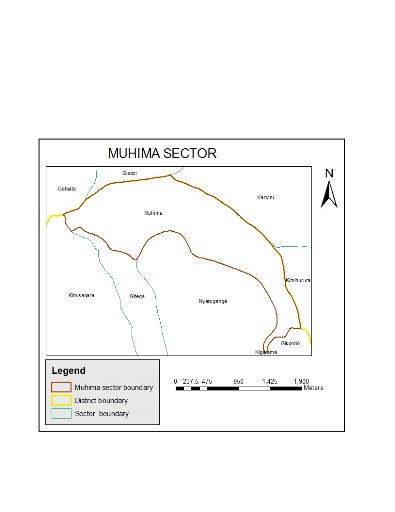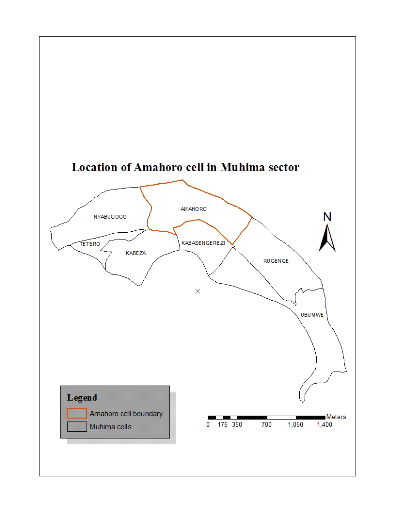3 RESEARCH METHODOLOGY
3.1 Study area
Kigali, the capital city of Rwanda is subdivided into 3
districts; Gasabo, Kicukiro and Nyarugenge. Amahoro cell which is the case
study is found in Muhima sector, one of the 10 sectors comprising Nyarugenge
District i.e. Gitega, Kinyinya, Kigali, Kimisagara, Mageragere, Muhima,
Nyakabanda, Nyamirambo, Nyarugenge, and Rwezamenyo. Muhima sector is populated
by 31, 866 people spread over 7 cells (Tetero, Kabeza, Kabasengerezi, Amahoro,
Nyabugogo, Ubumwe, Rugenge) with a total area of 292 hectares. It is
characterized by a habitat under-equipped and spontaneous. It is the subject of
urban restructuring that is part of a pilot project of the new blueprint for
the city of Kigali, which aims to make this site a hub of business.
Figure 1: Map of Muhima sector

Source: Administrative boundaries
of Rwanda; modified by author
Amahoro cell is further subdivided into six villages/
Imidugudu (see table 1):
Table 1: Number of households in Amahoro
cell
|
Sector
|
Villages/Imidugudu
|
Number of households
|
Population
|
Total population
|
|
Muhima
|
Amahoro
|
130
|
843
|
5,083
|
|
Amizero
|
415
|
914
|
|
Inyarurembo
|
126
|
555
|
|
Kabirizi
|
256
|
847
|
|
Ubuzima
|
395
|
989
|
|
Uruhimbi
|
254
|
935
|
Source: Executive
secretary/Amahoro cell
Amahoro cell is located at the northern part of Muhima sector
as the following map shows:
Figure 2: Location of Amahoro cell in Muhima
sector

Source: Rwanda Natural Resources
Authority
3.2 Data collection
methods
Data collection techniques refer to a set of methods and
principles that are used when conducting a study on a particular subject or
doing a particular kind of research work. This part shades light on the
different methods in which data needed for the research was obtained. These
techniques included:
3.2.1 Secondary data collection
Secondary data used in this research was obtained from
different publications from library and electronic sources. The publications
are categorized as follows:
3.2.1.1 National
documents and policies
In order to link the primary information and the researcher's
ideas with the government programs, different policies and laws were reviewed.
3.2.1.2 Spatial
datasets acquisition
Shape files of Rwanda administrative boundaries were extracted
from the geodatabase of Rwanda natural resources authority in order to localize
the study area on a map.
3.2.1.3 Academic documents
Dissertations and theses were consulted to find out how much
work already done on the topic in different parts of Rwanda or other parts of
the world by other academicians.
| 


